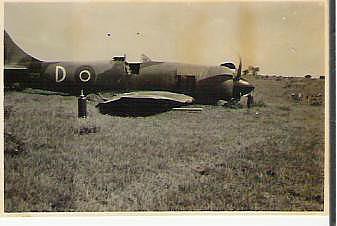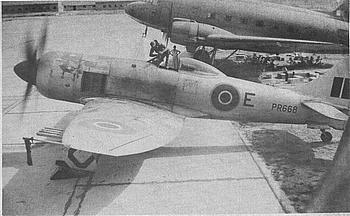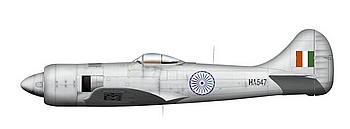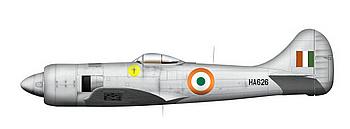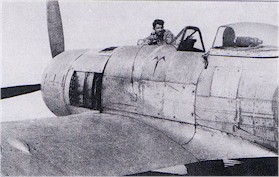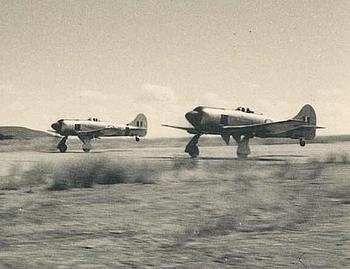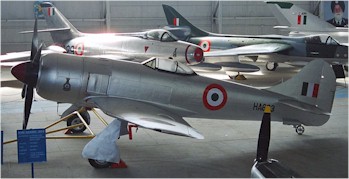Tempest Markings
All Tempest IIs that came to the RAF in India wore the three tone, light sea grey, RAF dark green and light grey scheme with sky fuselage band and colour of the spinner depending on the sqn. Since all came after the war, they dispensed with the two-colour wing roundel (also to prevent confusion with the Japanese Hinamaru). Almost all carried the type 1A 36 inch fuselage roundel with yellow border and a fin flash with the white just one inch wide. Serials were all 8 inch and night. Fuselage codes were typically white and 36 inch high until they were replaced by a single letter white (rarely black also) ID or removed completely.
Several Tempests were also painted with white South East Asia Command (SEAC) bands on nose, empennage, tail and fin. Some aircraft had these hurriedly over-painted in black leading to camouflaged aircraft having black tail and wingtip bands. In 1946 all Tempests were ordered to be painted in overall silver with a single black 36 inch ID code letter. The RIAF inherited all the three schemes as RAF squadrons departed India. In the initial hurly-burly of partition and the setting up of new bases, new equipment and new training centers (with almost all spares, equipment manuals and administrative records lost to the Pakistan Air Force at Drigh Rd, Karachi) very little changed from the RAF paint schemes and Tempests, as did other types, continued to operate in RAF schemes.
The RIAF issued a new paint scheme vide AFO (I) Tech1/48, National Markings for Aircraft) in Jan 48 requiring a navy blue ‘Chakra’ to be painted in the standard six positions and with the fin flash to continue with saffron forward. No evidence exists to indicate that the ‘Chakra’ was used on camouflaged Tempests. However, Hawker did supply several all silver aircraft in the second bought-out batch in factory painted blue chakras. Similarly, serials also remained unchanged till late in 1947 when the Indian colours were applied over the RAF roundels. Although the initial fin flashes appear to have simply replaced blue with green and red with saffron, some one with great foresight replaced red with green and blue with saffron in the roundels. This has allowed identification of nationality in black and white pictures by confused historians ever since. In keeping with the logic of the roundels, the fin flashes were subsequently reversed on all IAF aircraft commencing around late 1948 and completed only by the 60s; however, widths of each of the three Indian colours have always been equal.
One of the peculiar markings to appear on RIAF Tempests was the white wingtip. This required both wingtips to be painted white on both surfaces up to the aileron outer edge. The reason for this scheme is not clear yet. When the silver Tempests were relegated to the advanced training role at CTU, all the original ‘white areas’ simply changed to black with a black rudder being added for easier identification of training ac. The night serial when occurring on the black tail band became reverse silver. Several Tempests also acquired black anti glare panels towards the end of their careers. When engaged in the target-towing role at ATW, these black bands and wingtips were replaced by yellow, except for the rudder.
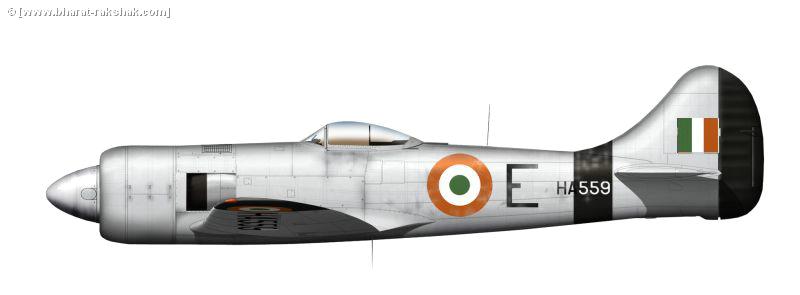 |
| A Tempest II in full black tail band, rudder and wing tip markings of the CTU. It also sports the single letter ID used at several times in the ac’s career. HA 559 ‘E’ (MW847) an ex 4 Squadron aircraft is seen in the photograph below whilst parked at Kanpur awaiting scrapping in 1961. Art work Tom Cooper ACIG.org |
 |
| Tempest II HA 635 (MW 388) was from the second lot of 89 aircraft supplied directly by Hawker from RAF stocks in the UK. It was one of the last four Tempests flown in the IAF. Here it is seen in the markings of the Target Towing Flight under ATW at Jamnagar in May 1955. It still carries it’s ex No 4 Squadron IAF blue spinner but has taken on a yellow tail band and wing tips for the role. It also sports a black anti glare panel on the nose. Artwork Tom Cooper ACIG.org |
Flying the Tempest: All Indian pilots who flew the Tempest came from Spitfire backgrounds but with varying experience. For those who came out of the Second World War on Spitfires, the Tempest was a huge lumbering hunk of metal with an engine that ran much rougher than the Spitfire’s sweet Merlin/Griffon. Initially it was not a pleasant aircraft to fly, but like all difficult airplanes in the years before and since, when you flew her well you had the satisfaction of having achieved something. “It was an aeroplane that you had to keep your eyes on, the moment you relaxed, it would bite you!” the “Bite” being the rather ready tendency to swing to starboard on landing. Even on take off with full boost the Tempest needed full rudder and opposite brake to keep her straight. In consequence, as Air Mshl S Raghvendran remembers, section take offs particularly in significant crosswinds, if accomplished correctly, were something to be proud of. One of the reasons for this was the loss of control caused by the blanking of the rudder by the flaps when the tail was lowered. Many pilots attempted to raise the flaps before lowering the tail and lost control while looking inside. On the other hand, several experienced pilots found the swing problem to be overstated. Sqn Ldr ML Mishra CO 7 Squadron who went solo on 02 Jun 47 felt that the Tempest was a – “glorified Harvard, except that one knew the direction it would swing to”. Air Chief Marshall IH Latif who commanded 4 Squadron on Tempests doesn’t recall any particular problem with landing the Tempest. On landing, the powerful brakes were almost a necessity if you wanted to keep her straight but it was easy to nose over with too much brake. In case of failed brakes or damaged tyres, the pilot’s notes required that a wheels-up landing be resorted to. As a consequence, during the 47-48 ops, a large number of Tempests were landed wheels up and significantly damaged when, ground fire shot away brakes or tyres. Once in the air the aircraft displayed crisp control and having much more power than the Spitfire, became a much livelier machine. However, the much larger cockpit of the Tempest did not allow the pilot to feel part of the machine as he did in the little Spitfire.
The CTU conversion called for 06:00 hrs on the Spitfire T Mk IX then 12:00 hrs on the Mk XVIII and then a similar 16:00 hrs on the Tempest II with a check ride halfway on the Spitfire T Mk IX. Pilots coming from Harvards didn’t find the Spitfire Mk XVIIIs easy to handle on take off. The immense torque coupled with the requirement to change hands on the stick to raise the undercarriage caused four fatalities and six write-offs in one four week period during the 52nd courses conversion onto the Spitfire in 1949. One pilot remembers that they were hurried onto the Tempest to make sure some of them survived the course. The Tempest’s true calling was of course the ground attack role. Its greater stability made it a great gun and rocket platform and its latter gyro gun sight also made it much more accurate. While many Spitfire pilots did not find it as “exhilarating”, they all appreciated its war like capabilities. It was by no means the ‘pilot’s aeroplane’ that the Spitfire was, but it was the aeroplane for the job that had to be done. Its outstanding performance in rocketing, strafing and bombing the enemy during the precarious ground situations of the 47-48 ops must surely overshadow its nagging engine and ground handling problems.
| A Tempest Cockpit. Pic courtesy: Dan Patterson, in “Cockpit”, ‘An illustrated history of WW II aircraft interiors’ by Donald Nijboer, | 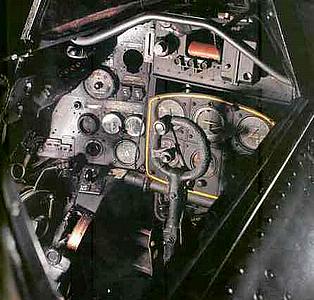 |
The Survivors
Of the total 452 Tempest IIs built, 124 were handed over to India and a further 109 were bought bringing the total to 223. By the end of 1955 a few examples survived as decoys mostly at Poona while the rest were scrapped at Kanpur/Chakeri. Of these, one example, HA 623 (MW848) has been maintained in pristine condition at the IAF museum at Palam.
By the late 50s, apart from the second prototype LA 607 and a single Mk V SN 219 (NV 778) in the UK, the only remaining Tempest airframes in the world (all PAF airframes being scrapped) were tucked away in the tall grass of Poona. Realising that IAF Tempests were the only Mk IIs left, the Indian Government in 1977 put up 11 Spitfire and Tempest airframes for auction as a complete lot at Jodhpur and Poona. Of these six composite Tempest airframes (HA 557 (MW404), 564 (MW376), 586 (MW 763), 591 (MW 810) and 604 (MW 401)) were exported to the UK by a team led by the late Doug Arnold while HA 580 (MW 758) and HA 457 (PR536) were also exported by other restoration groups. HA 591 was restored to static display condition and re exported to Nelson Ezell in the USA and HA 586 has been registered as G-TEMT in the UK and has been selected to fly. HA 604 has been registered as G-PEST and has been traded with the Imperial War Museum in the UK. One almost complete airframe HA 457 (PR 536) was acquired by the RAF museum (after being restored by the Fighter Collection at Duxford). This aircraft was an ex 5 Squadron RAF aircraft and was handed over to No 3 Squadron RIAF in 1946. It was recovered in 1977 and restored to static condition in its original RAF markings OQ-H in Nov 1991. Several RAF fuselages stored at the RAF museum at Hendon are also planned to be mated to IAF Tempest wings from this batch and by the end of the first decade of the millennium we just might hear a Tempest howl through the skies again.
Ex-IAF Tempest Survivors Today
| Serial No | RAF Serial No | Current Location |
| HA-623 | MW-848 | Indian Air Force Museum, Palam, India |
| HA-457 | PR-538 | Royal Air Force Museum, Hendon, UK |
| HA-557 | MW-404 | Under Restoration in Texas, USA by Chris Miller |
| HA-564 | MW-376 | Stored in France |
| HA-580 | MW-758 | Stored in UK |
| HA-586 | MW-763 (G-TEMP) | Under restoration with Tempest Two Ltd, UK |
| HA-591 | MW-810 | Stored Texas, USA |
| HA-604 | MW-401 (G-PEST) | Tempest Two Ltd, UK |
Further Reading:
- Battle Damage!– a 47 War story by Wg Cdr Donald Michael
- My experiences in the 47 Operations – Gp Capt MPO Blake VrC
- The Catterpillar Club – A Tempest bale out story by AVM C V Parker.
- No.58 Pilots Course at Conversion Training Unit, Hakimpet by K S Nair
- Pilot’s Notes – Hawker Tempest II – PDF File
- Hawker Tempest Serials (Select “Tempest” tab)
- Indian Hawker Tempest losses before 1947 – Warbirdsofindia.com
- Indian Hawker Tempest losses after 1947 – Warbirdsofindia.com
- Maha Vir Chakra Awardees of the 1947-48 Kashmir Operations
- Vir Chakra Awardees of the 1947-48 Kashmir Operations (Courtesy : Air Marshal Bharat Kumar)
- Tempestous Times – Indian Hawker Tempest Survivors overseas by K S Nair
- The RAF Museum’s ex-IAF Hawker Tempest by K S Nair
- The Hawker Tempest Website by Christer Landberg
- First Indo-Pakistani War, 1947-1949 – ACIG.org
Acknowledgements.
As always, most of the research on British types has been accomplished by mainly British enthusiasts. Most of the background material for this article, especially production serials and IAF serial tie-ups, has been based on the thorough work done by Christopher Shores and Chris Thomas in their book “The Typhoon and Tempest Story“. I am truly indebted to them. Several Journals and books also provided valuable information but most importantly, ex IAF Tempest pilots formed the backbone of my IAF research. Their help with photographs, information and anecdotes were invaluable. A list of these ‘contributors’, in no particular order, is placed below.
Publications and Online Resources
The Typhoon and Tempest Story by Chris Thomas and Christopher Shores, Arms and Armour Press GB 1988
The Aeroplane Monthly Magazine
Vayu Aerospace and Defence Review magazine
‘My Years in the IAF’ by Air Chief Marshal PC Lal
http://www.hawkertempest.se The Hawker Tempest Website by Christer Landberg
‘The Battle Axes’ by Pushpinder Singh
‘The Cobras‘ A history of No 3 Squadron IAF
“Cockpit”, ‘An illustrated history of WW II aircraft interiors’ by Donald Nijboer,
http://www.acig.org The Air Combat Information Group Website
Individuals
Air Chief Marshal (Retd) H Moolgavkar
Air Chief Marshal (Retd) IH Latif
Gp Capt (Retd) MPO Blake
Gp Capt (Retd) SR Powar
Air Mshl (Retd) Douglas King-Lee
Wg Cdr (Retd) Donald Michael
Air Mshl (Retd) MSD Wollen
Wg Cdr (Retd) JC Plomer
Wg Cdr (Retd) Ian loughran
Air Mshl (Retd) S Raghavendran
Gp Capt (Retd) Kishen Advani
Gp Capt (Retd) Kapil Bhargava
Wg Cdr (Retd) WH Marshall
Air Mshl (Retd) M Mc Mahon
Hon Flt Lt B Daniel
Jagan Pillarisetti
Pushpinder Singh
Tom Cooper
George Cull
Peter Arnold
Institutions
Indian Air Force Museum, New Delhi
The Imperial War Museum, Duxford UK
The Royal Air Force Museum, Hendon, UK

